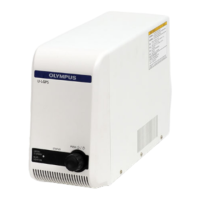What to do if Olympus U-LGPS Microscope lamp is too bright?
- WWilliam MartinezAug 3, 2025
If the lamp is too bright, insert the optical element in the light path of the microscope frame to adjust the brightness.

What to do if Olympus U-LGPS Microscope lamp is too bright?
If the lamp is too bright, insert the optical element in the light path of the microscope frame to adjust the brightness.
Why Olympus U-LGPS pilot lamp does not turn on even when the power switch is on?
If the pilot lamp does not turn on even when the power switch is set to ON, check the following: * Ensure the power cord is properly connected. * Ensure the power cord plug is properly connected. * If the above are correct, the fuse may be blown out. Replace the fuse with a new one.
What to do if the Olympus Microscope lamp is too dark?
If the lamp is too dark, ensure the liquid light guide is properly attached to the U-LLGAD and that the U-LLGAD is properly attached to the illuminator of the microscope frame. Connect them properly.
What to do if Olympus U-LGPS pilot lamp does not turn on when pressing the lamp switch?
If the pilot lamp does not turn on when pressing the lamp switch, ensure that the power switch is set to ON. If it is OFF, set the power switch to ON.
What to do if Olympus U-LGPS pilot lamp is blue, but the light from the lamp does not illuminate the sample?
If the pilot lamp is blue but the light from the lamp does not illuminate the sample, the shutter may be in the light path of the microscope frame. Remove the shutter from the light path.
What to do if Olympus Microscope U-LGPS control software in use stopped?
If the U-LGPS control software in use stopped, set the power switch to OFF, then turn the lamp back ON.
Why the liquid light guide cannot be attached to Olympus Microscope U-LGPS or U-LLGAD?
If the liquid light guide cannot be attached to U-LGPS or U-LLGAD, it may be because a non-conformable liquid light guide is being used. Use the conformable liquid light guide.
| Frequency | 50/60 Hz |
|---|---|
| Type | Laser Galvanometer Scanning Unit |
| Working Distance | Approximately 50 mm (depending on objective lens) |
| Scanning Method | Galvanometer mirror scanning |
| Input Voltage | 100-240 V AC |
Defines the intended users of the manual.
Explains the structure and symbols used in the manual.
Briefly describes the U-LGPS as a light source.
Specifies the product's intended applications.
Lists essential items and checks before operating.
Safety guidelines for product installation and placement.
Warnings about laser radiation and handling warning labels.
Precautions to avoid electric shock during operation and maintenance.
Practices for safe electrical operation and grounding.
Avoid direct exposure to light to prevent eye damage.
Advises on safe handling and usage of the liquid light guide.
Safety instructions for control software operation.
Details the location and purpose of caution labels.
Guidelines for careful handling and environmental considerations.
Instructions for cleaning the product to maintain performance and safety.
Advises on post-use procedures and storage conditions.
Informs about the expected operational lifespan.
Step-by-step guide to power on the light source.
Step-by-step guide to power off the light source.
Describes pilot lamp colors and counter displays.
Detailed steps for connecting the light guide.
Steps for connecting the USB cable for software control.
